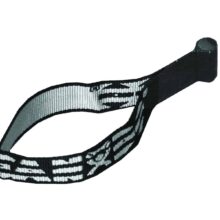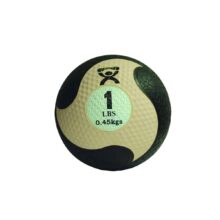Active Recovery Kit
Login For Dealer Pricing
The latex free Theraband Active Recovery Workout Kit is ideal for upper and lower body exercise for strengthening muscles, increasing your range of motion and improving your flexibility.

Muscle atrophy is a condition in which your muscles waste away. This usually (but not always) occurs due to lack of physical activity.
It typically occurs in individuals for whom physical activity has become difficult or impossible as a result of disease or injury.
Typically, the loss of muscle tissue shows up in the form of a reduction in size of the unused muscles. It may be difficult or impossible to move an arm or leg for an extended period. If so, the loss of muscle mass can cause that limb to gradually shrink compared to the other one.
In this article, we will examine the most common symptoms of muscle atrophy and then briefly discuss the usual causes. We will end with a discussion of the treatments currently available to slow or reverse this problem.
As always, the contents of this article should not be regarded as professional advice. If you think you are suffering from muscle atrophy, we would advise consulting with a medical professional. He or she will be able to properly diagnose your condition and then suggest the appropriate remedies.
As mentioned above, this condition usually causes a shrinkage of one or more of your limbs compared to the others.
Other potential indications of muscle atrophy include:
We have already stated above that this condition can be the result of an extended period of relative inactivity.
Reduced use of certain muscles can cause a marked decrease in their size and strength. For certain muscles, such as the weight bearing ones, this can take place even over a short period.
The inactivity that leads to muscle atrophy can itself be the result of:
In some cases, the reduction in muscle use can be caused by certain diseases or medical conditions. These diseases or events may make it impossible or difficult to continue using certain muscles. Examples are:
Other potential causes of muscle atrophy, that may not be due to an enforced period of inactivity, may include:
If you think you are seeing signs of muscle atrophy, the first step is to see your doctor.
Your doctor will probably start by reviewing your medical history. He or she will pay particular attention to previous injuries and any recent diagnoses of illness. You will likely also be asked to describe your symptoms in detail.
The doctor will probably want to request tests such as:
These tests will help your doctor to understand the causes of your muscle wastage. In particular, they may help to detect an underlying illness other than inactivity that is causing muscle tissue loss.
In deciding on the most appropriate treatment, your doctor will take account of the amount of muscle tissue lost. Priority will likely also be given to treating underlying medical conditions that may have led to the loss of muscle mass.
That said, as a first step, the recommended treatments might include:
Another treatment technique that may be employed is electrical muscle stimulation (EMS). This involves the use of electrical signals to induce muscle movement. Over time, repeated EMS treatments may help slow or reverse the atrophy.
Another approach to treating muscle atrophy involves surgery. In cases involving muscle tissue loss due to malnutrition, contracture deformity may result. If so, surgery may be the most effective way to address the deformity.
Surgery may also be effective if your muscle tissue loss is due to a torn tendon that prevents normal muscle use. In this situation, the goal of surgery will be to repair the damaged tendon and allow normal muscle use to resume.

Login For Dealer Pricing
The latex free Theraband Active Recovery Workout Kit is ideal for upper and lower body exercise for strengthening muscles, increasing your range of motion and improving your flexibility.

Login For Dealer Pricing
The Adjustable Ball Rebounder helps your strength by reflecting balls at a speed and angle consistent with the user’s throw. You can vary your workout by adjusting the angle between 0 and 42 degrees.

Login For Dealer Pricing
A combination set consisting of various combinations of a a Circular or Rectangular Rebounder, a 6-ball 1-tier horizontal rack and 5 pliable medicine balls (weighing 2, 4, 7, 11 and 15 lbs).

Login For Dealer Pricing
The resistance of each band can be increased or decreased by adjusting length of band used. The band is 8″ in length and 1″ in width. Available in extra light to extra heavy resistance levels.

Login For Dealer Pricing
The CanDo® Adjustable Exercise Band Kit is a portable, light-weight, exercise system. Available in different kits.

Login For Dealer Pricing
The Chest Weight Pulley System can function as a key part of an injury rehab program and is available with one, two or three handles.

Login For Dealer Pricing

Login For Dealer Pricing
This Dispens-a-Band® exercise band rack holds five 100-yard Perf 100™ dispenser boxes or any 50 yard dispenser boxes.

Login For Dealer Pricing
Dual Handle Medicine Ball that has been carefully designed for effective and productive total body or core workouts.

Login For Dealer Pricing
Dumbbell Floor Rack for storing up to 20 dumbbells. Dumbbells are not included.

Login For Dealer Pricing
This Mobile Studio Rack has a 1100 lb weight capacity and locking casters that keep it securely in place. Dumbbells are not included.

Login For Dealer Pricing
The Dumbbell Wall Rack holds up to 10 dumbbells and is ideal for those with limited floor space.

Login For Dealer Pricing
Band & Tubing Scissors are an important accessory for cutting exercise band and tubing down to the correct size.

Login For Dealer Pricing
30″ long loop is equivalent to 60″ of flat band cut and tied in a knot. Loop is 3″ wide. Convenient pre-formed loop is made of high quality latex exercise band. Loops arrive ready-to-use, you do not have to cut and tie it before performing exercises! 30″ long loop is specially sized for full body…

Login For Dealer Pricing
Door anchor with nub is used to anchor exercise band or tubing in a door jamb. Place anchor nub in door jamb at any height. Close door to create workout station! Heavy-duty webbing makes this accessory extra durable. Secure any size band or tubing to open loop of door nub strap.

Login For Dealer Pricing
Handles offer a comfortable grip when attached to exercise band and tubing. Can also be used with with the Cando adjustable bands.

Login For Dealer Pricing
Foam padded ridged handles make exercise band and tubing easy to use. The self-locking “adjuster” holds band and tubing in place during the most strenuous exercises. Use self-locking “adjuster” to increase or decrease resistance of exerciser by shortening or lengthening exercise band/tubing.

Login For Dealer Pricing
The CanDo® exercise band kit includes a loop stirrup, door disc, and a pair of handles – all essential for versatile workouts.

Login For Dealer Pricing
Loop Stirrup has two webbing loops: one large, one small. Simply place the band through the small webbing and put the other loop around any stationary object such as your foot, a door anchor or a wall anchor. The loop can be used in conjunction with handles to facilitate a wide range of exercises.

Login For Dealer Pricing
Feature wo lightweight, stackable plastic racks that hold ten 100-yard Perf 100™ rolls or any 50-yard rolls of resistive exercise band each. Cradle facilitates smooth dispensing of any exercise band.

Login For Dealer Pricing
An adjustable strap that attaches to Exercise Bungee Cords.

Login For Dealer Pricing
This exercise bungee cord is useful for either upper or lower body exercises and has a snap-hook on one end and a door jamb nub and a loop anchor on the other end.

Login For Dealer Pricing
360 Athletics Figure 8 Resistance Tubing offers a convenient way to take your exercise equipment along with you on the road and can be used at times that fit with your schedule to keep you in peak physical condition at all times.

Login For Dealer Pricing
Firm Medicine Ball designed for plyometric exercise. Choose from balls weighing between 1 and 30 pounds.